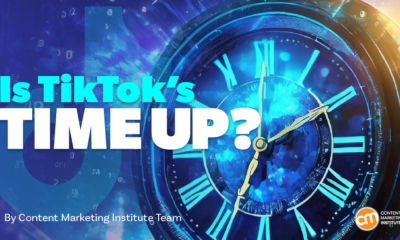Back in January 2018, I wrote a MarTech column with advice I give clients when the fiscal year is young.
I suggested you take some time off to plan your marketing strategy for the coming year. Forsake the hustle and distractions of the office and take your team to some offsite location where everybody can stretch their legs, let their minds run free and get the inspiration flowing.
I also included a five-point plan for auditing your email marketing program before starting the strategic planning process. This gave you a foundation and direction for your planning process. It also revealed how your team members felt about the work they’re doing.
A lot has changed since I wrote that column. How well does it hold up?
Time to rethink the email audit?
COVID-19 and its aftershocks certainly threw a big wrench into marketing operations, but it wasn’t the only factor reshaping the email landscape. Corporate restructuring, the “Great Resignation,” a new focus on “owned” data (zero-party and first-party data), economic and political upheavals and the continued evolution of marketing technology — all of these have left their marks on many email programs.
Here’s what I found: My initial advice still stands. (Yeah!) But now, I can see there’s more work to do to understand how your email program is performing and create the strategies that will help your program achieve its goals.
Now: A 10-point email audit for strategic planning
Yes, I gave you more work. But that means you’ll end up with an even more helpful document.
Even if you don’t do a full-blown strategic planning session every year (email marketing team of one, I’m talking to you), this audit will guide you through the background research you need to identify your email strengths and weaknesses and plot your course for the 12 months.
This research, and the insights you pull from it, become the basis for your strategic plan. Without this work, your planning retreat won’t go beyond aimless blue-sky banter. That’s not how you make your budget numbers or generate the kind of results that give you bragging rights about how well email helps your company achieve its goals.
Feel free to adjust my audit points, so they work with your company’s unique email situation or add areas that you think I missed. (If you do, tell me what you added!).
Numbers one through five below are the new points for your email audit. I also included the five from the previous version — for more details on those, check out my original blog post.
1. How do you measure success?
If you’re an e-commerce brand, your number one question should be, “How much money did this email campaign bring in?” The corollary to this question is, “Did it make as much money as I was expecting?”
All the metrics you use should help you answer that question: total revenue attributed to email, revenue per email, revenue per subscriber, and so on.
What doesn’t measure revenue? The open rate. It has never been a reliable success metric, but it has become even less so since 2021, thanks to Apple’s Mail Privacy Protection feature.
If your audit shows you rely on opens to report success to your bosses, you need to change it.
Read next: Study finds iOS 15 is inflating email open rates
2. What are you doing to keep your email lists clean and up to date?
List hygiene is more important than ever now for two reasons:
- We have to deal with more factors that pollute the database, like spoofed or disposable email addresses and out-of-date addresses, thanks to turnover from COVID-19 layoffs.
- As cookies phase out, the email address has become much more important as an audience identifier across channels. You have to be sure this primary data point is up to date. (See my point 6 below on acquiring primary email addresses, too.)
3. What’s the overall tone of your email content?
I’m looking at two drivers for this point:
- Many brands recalibrated their communications while the world was in lockdown to be more helpful and understanding. Sure, you still need to move product, but the “buy now” mentality is shifting toward “buy from us, and here’s why, and here’s how we can help.”
- Brand equity is more important than ever now that we’re in a world where people will freak out over a single public misstep. I was already talking about this in 2019, but COVID, social media and the world, in general, are making it even more essential to think about how your email campaigns build up or eat away at your brand.
4. How are your email automations working?
How long has it been since you reviewed all of the email programs you use besides your basic promotional campaigns?
I’m talking about a welcome program, transactional emails like abandonment, purchase, loyalty, repurchasing and reactivation.
In case you missed it, my latest MarTech column explained why your automations aren’t “set ’em and forget ’em” and what can happen when one goes rogue. Reviewing and recalibrating your automations should get built into the construction process.
Also, consider what new technology could help you solve some long-standing problems. You might be more data-dependent now than you were a few years ago. Could a central data platform (CDP) help you send better emails?
5. Where could you achieve better returns by bringing in outside help?
If we learned anything about email over the last 2.5 years, it’s that email works. But making it work right takes time and resources.
If you don’t have the budget to hire full-time help, look for places where you could bring in contractors or an outside agency to take on some of the work you struggle with.
The recent layoffs at major tech companies have created a big pool of talented people who can bring an outsider’s viewpoint and specialized skills.
Here’s a thought: Hire one of them to audit your email program. You’ll get insights from someone who isn’t beholden to company politics or how things have always been done.
Get the daily newsletter digital marketers rely on.
6. Are you asking customers and users for their primary email addresses?
Multiple studies show that the average consumer has up to three email addresses, one of which is their primary email address. What are you doing to sell your program to get the right one?
The primary email address is the one your customers check most often. Emails to primary addresses are more likely to be opened and acted on.
It’s also the one they guard most carefully. If you want people to give you their primary email addresses, you must give them realistic expectations of your program’s value.
7. How do your transactional emails make money for your email program?
This requires a specific focus on your transactional emails and is separate from your overall periodic review. Here you assess how much revenue those emails bring in — and what your customers do with them (open or click on them, go back to their carts, or ignore them.)
To judge any potential opportunity, I have worked with retail companies that generate 30% to 50% or more of their email revenue from transactional and triggered emails. This is a good bar to measure your own performance.
The age-old guidance is that you can use 20% of your transactional email for promotional purposes. That’s enough space to get a connected product for upselling or cross-selling.
You might need to revise your email template to update the branding, clarify the benefits, or smooth out the path back to the cart.
8. What’s your campaign workflow?
Ask each team member to write down the process you go through, from campaign research to email launch.
- Does everybody understand each step?
- Which steps get overlooked?
- Is there any step that has become the rule and not the exception that you should add?
You might discover that team members don’t understand what everybody’s role is in pulling a campaign together.
Another benefit: This evaluation can reveal where the process breaks down and introduces errors or lost time.
Everybody outside the email team thinks email is either easy or a peripheral contributor to the company’s success.
One of your jobs as an email team leader is letting everybody know just how badass email is.
After you figure out whether your emails are succeeding (see point 1), you need to broadcast that success to everybody who has a hand in deciding the email team’s fate – from budget to hiring to fast-tracking IT requests.
What could help you get the word out to your boss, to other marketing teams, and ultimately to the boss of your boss’s boss?
10. What do you want to accomplish in the next six to 12 months?
This is separate from meeting your team’s revenue goal, and it comes last on the list for a reason.
A thorough audit should expose opportunities as well as weaknesses. Have each team member list one or two things that could move the needle.
Think like the marketer you are, too. Explain the goal, the strategy for achieving it, and the tactics you’ll need to implement your strategy — especially if you want to add technology.
One last step…
Write everything down and put everything into a master document for every team member to consult. Go old school and print it out if you want.
Doing so will keep everyone on the same page, so to speak, and keep your team pulling together.
A pitch for bringing back the strategic planning session
If COVID-19 didn’t kill the offsite planning retreat, it definitely put the experience on pause. But now might be a good time to bring it back.
Ideally, this planning retreat would happen at a beachside resort with an 18-hole championship golf course and fine dining nearby. But even if your budget will stretch only far enough to cover box lunches in the boardroom, the concept is the same: Get the gang together, lock the doors, turn off your phones, and think long and hard about what you need to accomplish in the coming year and what you have to do to get there.
Having everybody on Zoom doesn’t cut it because you still have outside distractions, and video-call fatigue is real.
You need this time away from the email grind. Refocus on what’s coming beyond getting your next campaign to get out of the door.
A strategic plan will help you identify your goals and objectives and outline the strategies you need to use, along with the tactics that will carry out those strategies.
You’ll probably want to modify some things if COVID is still a challenge. Some team members will never feel comfortable in in-person gatherings anymore. But it’s worth the effort to try to restart in-person strategic planning even if your company is 100% remote.
Opinions expressed in this article are those of the guest author and not necessarily MarTech. Staff authors are listed here.

















![How to Use AI For a More Effective Social Media Strategy, According to Ross Simmonds Download Now: The 2024 State of Social Media Trends [Free Report]](https://articles.entireweb.com/wp-content/uploads/2024/04/How-to-Use-AI-For-a-More-Effective-Social-Media.png)




























You must be logged in to post a comment Login